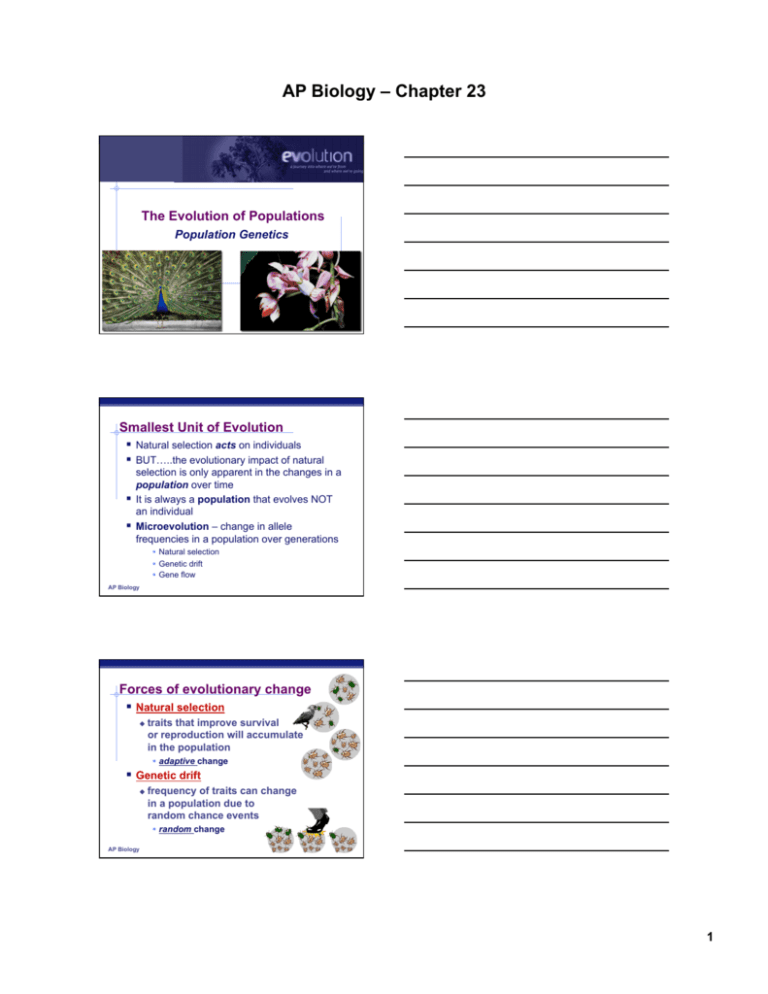Ch23_Population Genetics
advertisement

AP Biology – Chapter 23 The Evolution of Populations Population Genetics AP Biology 2007-2008 Smallest Unit of Evolution Natural selection acts on individuals BUT…..the evolutionary impact of natural selection is only apparent in the changes in a population over time It is always a population that evolves NOT an individual Microevolution – change in allele frequencies in a population over generations Natural selection Genetic drift Gene flow AP Biology Forces of evolutionary change Natural selection traits that improve survival or reproduction will accumulate in the population adaptive change Genetic drift frequency of traits can change in a population due to random chance events random change AP Biology 1 AP Biology – Chapter 23 Causes of MicroEvolution 1. Genetic Variation – great amount of genetic variation can only be determined with biochemical methods (Darwin unaware of much variation) Genetic variation can only be observed at the molecular level. Ex: cannot identify blood type from his or her appearance Characters that vary within a population may be discrete or quantitative Discrete – ex: color of Mendel’s pea plants (purple or white flowers) classified on an either-or basis Quantitative – influence of two or more genes on a single phenotypic character. Vary along a continuum within a population AP Biology Average Heterozygosity The average percent of loci that are heterozygous Two different alleles for a single locus Fruit fly example Nucleotide variability Gene variability (average heterozygosity) AP Biology Variation Between Populations Geographic Variation – differences in the genetic composition of separate populations mice population – evolved in isolation Karyotype differences Variation resulted from chance events Cline Other types of variation occur as a cline Graded change in a character along a geographic axis AP Biology 2 AP Biology – Chapter 23 Mutations Ultimate source of new alleles Change in the nucleotide sequence of an organism’s DNA Only mutations in cell lines that produce gametes can be passed to offspring Point Mutations Change in one base in a gene Unlikely that a mutation will improve the phenotype Increases variability HIV viral mutations Sexual reproduction AP Biology Measuring Evolution of Populations AP Biology 2010-2011 5 Agents of evolutionary change Mutation Gene Flow Chemical Changes to DNA AP Biology Migration Non-random mating Sexual Selection Genetic Drift Selection Small population Natural Selection Differential Survival 3 AP Biology – Chapter 23 Gene Pools and Allele Frequencies Population – group of individuals of the same species that live in the same area, interbreed, producing fertile offspring Gene Pool – consists of all the alleles for all the loci in all individuals of the population If only one allele exists for a particular locus in a population that allele is fixed in the gene pool Each allele has a frequency (proportion) in the population p and q allele frequency representations Sum of all allele frequencies must equal 1 (100%) AP Biology Hardy-Weinberg Theorem Mathematical principle that attempts to determine the current allele frequencies in a population The frequencies of alleles and genotypes in a population will remain constant from generation to generation Provided that only Mendelian segregation and recombination of alleles are at work Sets up the necessary conditions for a population to NOT evolve Focus is on the combination of alleles in ALL of the genetic crosses in a population AP Biology Hardy-Weinberg equilibrium Hypothetical situation serves as null hypothesis non-evolving population REMOVE all agents of evolutionary change 1. no genetic drift (very large population size ) 2. no gene flow (no migration in or out) 3. no mutation (no chemical change to DNA) 4. random mating (no sexual selection) 5. no natural selection (equal survival) AP Biology 4 AP Biology – Chapter 23 HW Conditions No mutations Random mating No natural selection Extremely large population size No gene flow Departure from any of these conditions usually results in evolutionary change! It is also common for natural populations to be in HW equilibrium for specific genes AP Biology Hardy-Weinberg Equation p2 + 2pq + q2 = 1.0 and p + q = 1.0 p2 = frequency of individuals homozygous dominant 2pq = frequency of individuals heterozygous q2 = frequency of individuals homozygous recessive AP Biology Example of strong selection pressure Tay Sachs primarily in Ashkenazi Jews & Cajuns recessive disease = aa lysosomal storage disease lack of one functional digestive enzyme in lysosome build up undigested fat in brain cells children die before they are 5 years old So where do new cases of come from? APTay-Sachs Biology 5 AP Biology – Chapter 23 Example of heterozygote advantage Sickle cell anemia inherit a mutation in gene coding for one of the subunits in hemoglobin oxygen-carrying blood protein normal allele = Hb mutant allele = Hs recessive trait = HsHs low oxygen levels causes RBC to sickle clogging small blood vessels damage to organs AP Biology often lethal Sickle cell frequency High frequency of heterozygotes 1 in 5 in Central Africans = HbHs unusual for allele with severe detrimental effects in homozygotes 1 in 100 = HsHs usually die before reproductive age Why is the Hs allele maintained at such high levels in African populations? Suggests some selective advantage of being heterozygous… HbHs AP Biology Single-celled eukaryote parasite (Plasmodium) spends part of its life cycle in red blood cells Malaria 1 liver 2 AP Biology 3 6 AP Biology – Chapter 23 Heterozygote Advantage In tropical Africa, where malaria is common: homozygous dominant (normal) homozygous recessive heterozygote carriers reduced survival or reproduction from malaria: HbHb reduced survival & reproduction from sickle cell anemia: HsHs survival & reproductive advantage: HbHs Hypothesis: In malaria-infected cells, the O2 level is lowered enough to cause sickling which kills the cell & destroys the parasite. AP Biology Frequency of sickle cell allele & distribution of malaria Any Questions?? AP Biology 2010-2011 7






